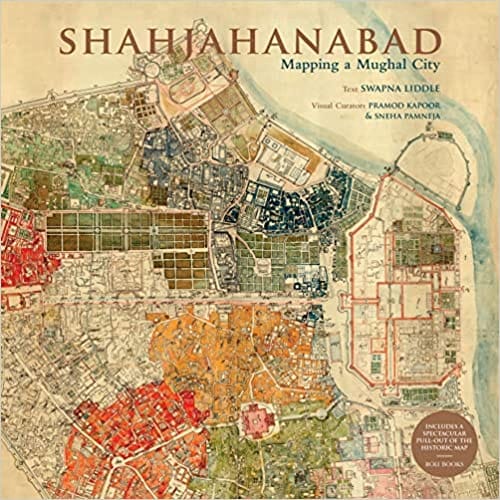WELCOME TO MIDLAND BOOK SHOP!
SHOP FOR
- Contemporary Fiction
- Contemporary Fiction
- Children
- Children
- Comics & Graphic Novels
- Comics & Graphic Novels
- Non-Fiction
- Non-Fiction
- Fiction
- Fiction
Shop No.20, Aurobindo Palace Market, Hauz Khas, Near Church +91 9818282497 | 011 26867121 110016 New Delhi IN
Midland The Book Shop ™
Shop No.20, Aurobindo Palace Market, Hauz Khas, Near Church +91 9818282497 | 011 26867121 New Delhi, IN
+919871604786 https://www.midlandbookshop.com/s/607fe93d7eafcac1f2c73ea4/677cda367903fd013d69b606/without-tag-line-480x480.png" [email protected]9789392130182 6447bacea012ff3230fcc975 Shahjahanabad Mapping A Mughal City https://www.midlandbookshop.com/s/607fe93d7eafcac1f2c73ea4/6447bacfa012ff3230fcc9b9/61boz83pjxl-_sy498_bo1-204-203-200_.jpg 9789392130182
Delhi’s Shahjahanabad was first founded as an empire’s capital at the glorious height of the Mughal dynasty; from this vantage point, it was also witness to the empire’s decline and eventual extinction. The city would transform profoundly in the aftermath of the Revolt of 1857, with many of its neighbourhoods and buildings obliterated, and many of its inhabitants, including the Mughal emperor, Bahadur Shah Zafar, having left, never to return. Fortunately, a mapmaker, working in 1846, painstakingly depicted important buildings, streets, and landmarks, providing a wealth of information about the city as it had evolved up to that time.
Shahjahanabad reproduces this large-scale, beautifully drawn and coloured map, and considers the city as it had stood prior to its mid-nineteenth-century changes. It also examines the city, neighbourhood by neighbourhood, and explores its diverse communities and important landmarks. This book is a must-have for anyone interested in cartography and Delhi’s vibrant cultural history.
Shahjahanabad reproduces this large-scale, beautifully drawn and coloured map, and considers the city as it had stood prior to its mid-nineteenth-century changes. It also examines the city, neighbourhood by neighbourhood, and explores its diverse communities and important landmarks. This book is a must-have for anyone interested in cartography and Delhi’s vibrant cultural history.
About the Author
Swapna Liddle works to raise awareness about the architectural and cultural history of Delhi, and is the author of books, including Connaught Place and the Making of New Delhi and Chandni Chowk: The Mughal City of New Delhi.
in stockINR 1996
1 1
Email ID already exists!
Your Current password is incorrect
Password Updated Successfully
Thanks for your Feedback
Shahjahanabad Mapping A Mughal City
ISBN: 9789392130182
₹1,996
₹2,495 (20% OFF)SIZE GUIDE
Sold By: Hauz Khas - Aurobindo Market
Details
- ISBN: 9789392130182
- Author: Swapna Liddle
- Publisher: Roli Books
- Pages: 108
- Format: Hardback
Book Description
Delhi’s Shahjahanabad was first founded as an empire’s capital at the glorious height of the Mughal dynasty; from this vantage point, it was also witness to the empire’s decline and eventual extinction. The city would transform profoundly in the aftermath of the Revolt of 1857, with many of its neighbourhoods and buildings obliterated, and many of its inhabitants, including the Mughal emperor, Bahadur Shah Zafar, having left, never to return. Fortunately, a mapmaker, working in 1846, painstakingly depicted important buildings, streets, and landmarks, providing a wealth of information about the city as it had evolved up to that time.
Shahjahanabad reproduces this large-scale, beautifully drawn and coloured map, and considers the city as it had stood prior to its mid-nineteenth-century changes. It also examines the city, neighbourhood by neighbourhood, and explores its diverse communities and important landmarks. This book is a must-have for anyone interested in cartography and Delhi’s vibrant cultural history.
Shahjahanabad reproduces this large-scale, beautifully drawn and coloured map, and considers the city as it had stood prior to its mid-nineteenth-century changes. It also examines the city, neighbourhood by neighbourhood, and explores its diverse communities and important landmarks. This book is a must-have for anyone interested in cartography and Delhi’s vibrant cultural history.
About the Author
Swapna Liddle works to raise awareness about the architectural and cultural history of Delhi, and is the author of books, including Connaught Place and the Making of New Delhi and Chandni Chowk: The Mughal City of New Delhi.
User reviews
NEWSLETTER
Subscribe to get Email Updates!
Thanks for subscribing.
Your response has been recorded.

India's Iconic & Independent Book Store offering a vast selection of books across a variety of genres Since 1978.
"We Believe In The Power of Books" Our mission is to make books accessible to everyone, and to cultivate a culture of reading and learning. We strive to provide a wide range of books, from classic literature, sci-fi and fantasy, to graphic novels, biographies and self-help books, so that everyone can find something to read.
Whether you’re looking for your next great read, a gift for someone special, or just browsing, Midland is here to make your book-buying experience easy and enjoyable.
We are shipping pan India and across the world.
For Bulk Order / Corporate Gifting
 +91 9818282497 |
+91 9818282497 |  [email protected]
[email protected]
Click To Know More
INFORMATION
ACCOUNT
QUICK LINKS
ADDRESS
Midland Book Shop - Hauz Khas
Shop No.20, Aurobindo Palace Market, Near Church, New Delhi
Shop No.20, Aurobindo Palace Market, Near Church, New Delhi














